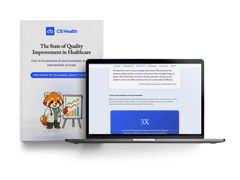
Driving Operational Efficiency in Hospitals With Advanced Tech Solutions
Digital transformation in hospitals can be gradual, but advanced tech solutions offer an opportunity to drive operational efficiency and improve patient outcomes. That's important because operational efficiency-or inefficiency at that-can have direct impacts on how quickly you can make decisions, how well-orchestrated your team is in their efforts to provide care, and how easily a patient is able to move through the hospital during their care.
New technology is regularly being developed to support healthcare providers in providing quality care and effective working environments.
» Want to improve your team's wellbeing? Explore how to address staff burnout in healthcare
Meet the Expert
Ido Zamberg M.D. is a board-certified physician (General Internal Medicine and Anesthesia), currently a Fellow at the Division of Experimental Medicine, McGill University Health Center, Montreal, Canada.
3 Key Challenges in Hospital Operational Efficiency
1. Communication
In large hospital settings, keeping everyone updated and communicating efficiently can be complex. This is especially true when a patient's care involves a team across different departments. The urgency and high-stakes environment of critical situations, like resuscitation, intensify these challenges, blocking clear and concise communication among healthcare providers.
2. Coordination of Care
Coordinating care between different departments and providers can be another major challenge in hospital operations. This used to be a manual tracking process, using a pen and paper, but as technology has evolved, it's opened up better streams of doing this.
The coordination starts from the moment a patient arrives at the ER, to when they enter the ward or operating room, and then back to the ward. Though it's true for all patients, it's particularly essential to have a robust coordinated effort for complex patients who may require care from multiple specialists.
All providers involved in the patient's care should be aware of the patient's condition and treatment plan, and must communicate effectively with each other.
Knowledge management solutions can help improve inter-departmental collaboration. Download our latest report to learn more.
3. Rigorous Compliance and Process
Hospitals must comply with a comprehensive set of regulations to ensure patient safety and high-quality care. These regulations, however, can create obstacles when introducing new technologies and processes. Getting regulatory approval can be protracted and intricate.
Despite the increasing necessity for hospitals to exhibit flexibility and adaptability in response to the dynamic nature of healthcare needs, these stringent compliance and process requirements can impede rapid adaptation.
» Looking to improve quality of care? Check out essential ways to reduce medical errors
5 Ways Technology Can Help Hospital Operational Efficiency
1. Real-Time Patient Journey Tracking
Efficient patient flow reduces bottlenecks and optimizes how you can use your resources. With consolidated systems, you can get coordinated real-time updates across your in-hospital devices for faster decision making. Systems can use predictive analytics to anticipate patterns and disruptions, optimize bed allocation, and facilitate an easy discharge.
2. Accessible Patient Information
Electronic medical records (EMRs), although not new, have played a crucial role in solving issues with tracking patient data and ensuring readily available patient history. By centralizing patient data in a secure digital format, EMRs streamline various aspects of healthcare delivery.
3. Reliable Collaborative Care
Digital communication and collaboration platforms enable easy exchange of information, ensuring everyone involved in a patient's care is on the same page. In a clinical setting, this could involve the use of pagers or alarms in each room for immediate notifications, which offer quick methods of communication in fast-moving settings.
Central to this collaborative approach is the implementation of comprehensive care protocols. A recent European study on complex spine surgeries highlighted the impact of such protocols. Carefully designed for every stage of the surgical process, these protocols significantly reduced hospital and ICU stays, demonstrating their transformative effect on patient outcomes.
However, the creation of these protocols is just one aspect of optimizing patient outcomes. The other element is their effective implementation. This is where tech-led systems like the C8 Health platform come into play. By centralizing care guidelines and best practices, these platforms ensure that everyone involved in patient care has immediate access to vital information, fostering improved communication, collaboration, and coordination.
4. Quick Decision Making
Today, technology can be embedded in pre-hospital care, ensuring a seamless flow of information before your patient steps into the hospital. This starts in the field, where CT scans and EKGs can be sent straight from ambulances to each healthcare provider that needs it, so everyone on the team is ready, enabling faster decision-making in acute care.
For anesthesiologist, Dr Daniel Katz (Vice Chair of Education, Department of Anesthesia, Mount Sinai), having a solution like C8 has maximized efficiency.
5. Enhanced Diagnosis and Interventions
Advanced devices in healthcare refer to cutting-edge medical equipment that utilizes sophisticated technologies to enhance patient care and improve operational efficiency. These devices encompass a wide range of applications, from diagnostic tools to therapeutic interventions, and play a crucial role in modern medicine.
I'll take an example from the world of anesthesia because a lot of our day-to-day involves using technology. One major recent advance was the pediolaryngoscopy, allowing for intubations with visibility on a small screen. This significantly reduces the challenge of blind intubations, marking a huge advance.
The benefits of advanced devices extend far beyond intubation. Robotics, for instance, has revolutionized surgical procedures, offering minimally invasive options with improved precision and reduced recovery times. Medical imaging modalities, such as MRI and CT scans, provide detailed anatomical insights, enabling early diagnosis and targeted treatment planning.
» Aiming to improve your bottom line and efficiency? Here's how to reduce costs in healthcare
Coordinated Care Through Technology Drives Operational Efficiency
People are hungry for innovative technology that powers up their lives-and healthcare professionals are no exception. Improving operational efficiency through advanced technology has important knock-on effects on patient care. With tech-driven platforms like C8 Health that offer centralized collaboration, we can ensure industry best practices and institution-wide guidelines are easily accessible, regularly updated and on the go.


